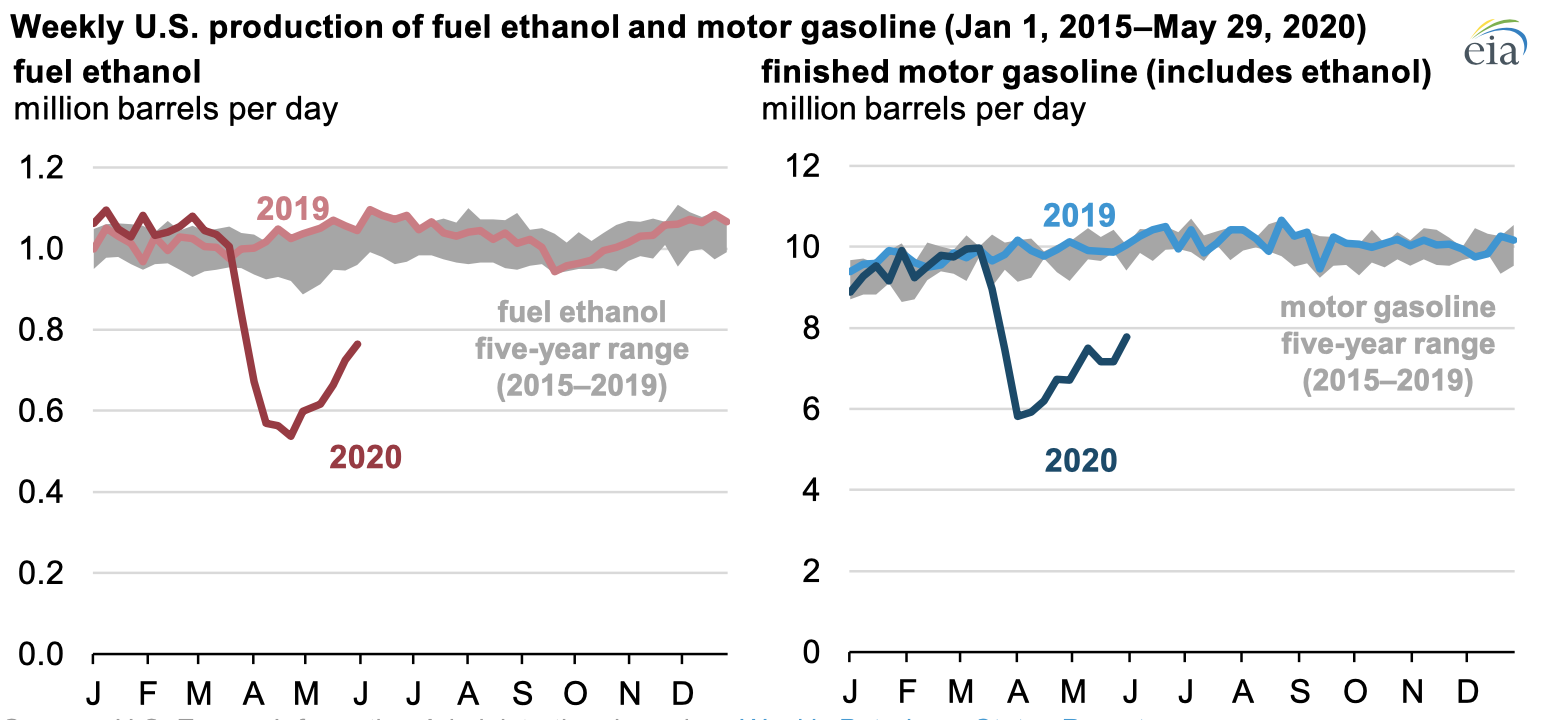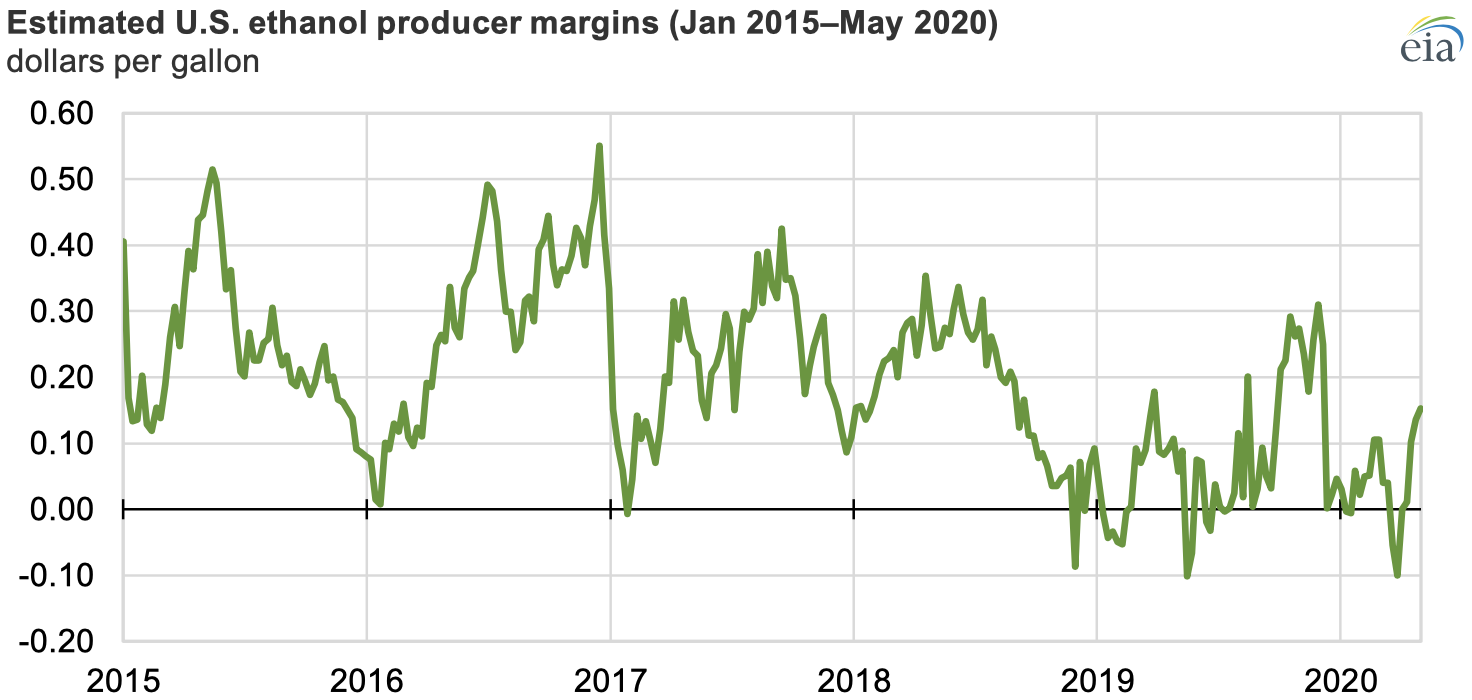U.S. fuel ethanol production and inventory changes have largely followed motor gasoline
Jun 08, 2020U.S. fuel ethanol production fell dramatically during late March and in April 2020, driven by significant reductions in motor gasoline demand as a result of mitigation efforts for the 2019 novel coronavirus disease (COVID-19). Fuel ethanol production fell to 537,000 barrels per day (b/d) in the week ending April 24, which was the lowest level on record since June 2010, when the U.S. Energy Information Administration (EIA) began collecting weekly fuel ethanol production data. Because almost all finished motor gasoline sold in the United States is blended with 10% ethanol (E10), the drop in gasoline demand has driven similar decreases in fuel ethanol demand and, correspondingly, fuel ethanol production.

” src=”https://www.ajot.com/images/uploads/article/eia-us-ethenol-oroduction-06092020-2.png”>

As a result of reduced economic activity and stay-at-home orders aimed at slowing the spread of COVID-19, transportation fuel demand has sharply declined since March. Weekly U.S. motor gasoline product supplied fell to its lowest level on record during the week ending April 3. Fuel ethanol production reached a low point three weeks later.
Sharp reductions in motor gasoline blending demand reduced already weak fuel ethanol operating margins, leading many plants to suspend operations entirely or significantly reduce output. Press reports indicate that nearly 30% of the nation’s fuel ethanol plants have been idled since early March, while another 35% have reduced production.
EIA’s weekly fuel ethanol production data show that U.S. fuel ethanol output averaged 586,000 b/d for the four weeks ending April 24, 2020, 43% less than the average of the four weeks ending April 26 of last year, largely matching the decrease in weekly motor gasoline product supplied over the same period. However, because supply still exceeded demand, fuel ethanol inventories increased to record-high levels in April. Total motor gasoline inventories also hit record highs in April.

Before country-wide mitigation efforts were implemented in response to COVID-19, fuel ethanol inventories were already trending at some of their highest seasonal levels in early 2020 because of relatively flat U.S. gasoline demand and limited domestic fuel ethanol demand growth beyond E10. U.S. fuel ethanol inventories reached an all-time record level of 27.7 million barrels during the week ending April 17, which was 22% higher than at the same time last year. As gasoline demand has begun to gradually recover, fuel ethanol inventory levels decreased to 22.5 million barrels for the week ending May 29, similar to their value in late May 2019.

The sharp reductions to demand and all-time record inventories have led to estimated U.S. fuel ethanol producer margins briefly going negative in March. Estimated fuel ethanol margins were negative as recently as 2019 because of rising corn prices and high fuel ethanol inventory levels. Negative fuel ethanol producer margins in March 2020 drove many fuel ethanol production facilities to have to idle or shut down production capacity, driving the record-low production rates in April.
In its latest Short-Term Energy Outlook, EIA forecasts that U.S. fuel ethanol production will average 0.87 million barrels per day (b/d) in 2020, about 15% lower than the 2019 average. EIA expects fuel ethanol margins to gradually increase, but lower U.S. motor gasoline demand will keep fuel ethanol production levels lower than 2019 levels in 2020. EIA forecasts that U.S. fuel ethanol production will increase in 2021 to reach an average of 0.97 million b/d.
Principal contributors: Sean Hill, Estella Shi
Similar Stories
FTR Reports U.S. trailer net orders in December at 25,334 units, the most since October 2023
Total trailer production declined 10% m/m in December to 11,827 units, a relatively typical seasonal drop. However, production was down 40% y/y – 43% below the five-year December average –…
View Article
2024 marks record air cargo year for Vienna Airport
View Article
Today in Energy: A look back at our forecast for global crude oil prices in 2024
View Article
WorldACD Weekly Air Cargo Trends (week 2) - 2025
View ArticleDaphne Technology and Williams secure DOE grant to advance methane emission reduction technology
Daphne Technology, in partnership with Williams, has announced the award of a grant worth nearly $6M from the U.S. Department of Energy's (DOE) Methane Emissions Reduction Program (MERP).
View Article
Solar Prize Round 8 semifinalists & power up contest winners
View ArticleGet the most up-to-date trending news!
SubscribeIndustry updates and weekly newsletter direct to your inbox!





